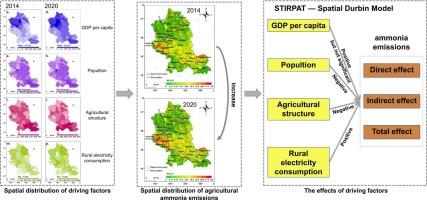Driving forces of agricultural ammonia emissions in semi-arid areas of China: a spatial econometric approach
IF 12.2
1区 环境科学与生态学
Q1 ENGINEERING, ENVIRONMENTAL
引用次数: 0
Abstract
Ammonia emissions contribute to PM2.5 formation, posing significant threats to public health, including respiratory and cardiovascular diseases, and causing various ecological issues, such as soil and water acidification. This study investigates ammonia emissions in the semi-arid region of central Gansu Province, China, by establishing a county-level agricultural ammonia emission inventory for 2014–2020 using the emission factor method. A spatial econometric model, integrated with the STIRPAT (Stochastic Impacts by Regression on Population, Affluence, and Technology) model, is employed to identify key drivers of emissions. This approach is crucial because it accounts for the spatial dependencies of emissions across regions and incorporates socio-economic factors, providing a more comprehensive understanding of emission patterns. Results indicate that livestock and poultry farming (58.76%) and nitrogen fertilizer application (37.73%) are major contributors to ammonia emissions. Regional agricultural ammonia emissions are concentrated in the east, river basins, and parts of the southwest. The study also reveals positive spatial clustering and spillover effects of ammonia emissions. In the central region of Gansu Province, a 1% increase in per capita GDP, population, agricultural structure, and rural electricity consumption leads to changes in agricultural ammonia emissions of 0.059%, -1.181%, -0.109%, and 0.133%, respectively. Rural electricity consumption, population dynamics, and agricultural structure improvements influence not only locally but also across neighboring regions. The findings emphasize the need for targeted, collaborative regional strategies to mitigate emissions and underscore the importance of considering spatial interactions in emission reduction policies.

求助全文
约1分钟内获得全文
求助全文
来源期刊

Journal of Hazardous Materials
工程技术-工程:环境
CiteScore
25.40
自引率
5.90%
发文量
3059
审稿时长
58 days
期刊介绍:
The Journal of Hazardous Materials serves as a global platform for promoting cutting-edge research in the field of Environmental Science and Engineering. Our publication features a wide range of articles, including full-length research papers, review articles, and perspectives, with the aim of enhancing our understanding of the dangers and risks associated with various materials concerning public health and the environment. It is important to note that the term "environmental contaminants" refers specifically to substances that pose hazardous effects through contamination, while excluding those that do not have such impacts on the environment or human health. Moreover, we emphasize the distinction between wastes and hazardous materials in order to provide further clarity on the scope of the journal. We have a keen interest in exploring specific compounds and microbial agents that have adverse effects on the environment.
 求助内容:
求助内容: 应助结果提醒方式:
应助结果提醒方式:


